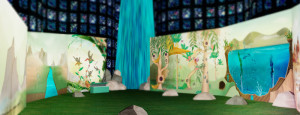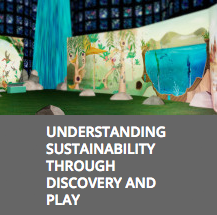Based on a submission by Stephen Uzzo about NYSCI’s NSF-funded project to explore issues of sustainability within the context of imaginative, playful, immersive worlds.
 By interfacing gesture and location tracking technologies to computer animation and environmental models, “Connected Worlds” helps visitors to the New York Hall of Science notice connections and build understandings of complex systems. Groups of museum visitors are able to formulate common goals, take on different roles and responsibilities and solve problems while exploring issues of sustainability within the context of imaginative, immersive worlds. This experience serves as a cyberlearning platform to elicit systems thinking, elucidate complex sustainability ideas, and allow learning scientists to study how people interact and cooperate in live, technology-mediated spaces.
By interfacing gesture and location tracking technologies to computer animation and environmental models, “Connected Worlds” helps visitors to the New York Hall of Science notice connections and build understandings of complex systems. Groups of museum visitors are able to formulate common goals, take on different roles and responsibilities and solve problems while exploring issues of sustainability within the context of imaginative, immersive worlds. This experience serves as a cyberlearning platform to elicit systems thinking, elucidate complex sustainability ideas, and allow learning scientists to study how people interact and cooperate in live, technology-mediated spaces.
NSF Project Information
Title: DIP: Interaction Research in Complex Informal Learning Environments
Award Details
PIs: Stephen Uzzo, Marc Levy, Jan Plass, Eric Siegel, Margaret Honey
The Connected Worlds exhibition, opening in October 2014 in the New York Hall of Science’s Great Hall, invites visitors to explore issues of sustainability within the context of imaginative, playful, immersive worlds. Through state-of-the-art sensing technologies visitors engage with any one of the six diverse ecosystems created through projected, dynamic, real-time animated imagery. Visitors interact with the imagery through gestures and manipulation of computer-tracked objects (such as logs and rocks). The effects they produce model complex systems of interdependent relationships among and within human-nature coupled systems. Each habitat connects with the others through water – their shared resource – that the visitors must manage to maintain healthy environments. Visitors have the opportunity to notice and explore complex issues of resilience and sustainability. The exhibition will be experienced by approximately 450,000 visitors each year, and will result in a body of research examining the ways in which young people interact in the environment to understand systems concepts.
The tracking and sensing system built into Connected Worlds allows analytics to be built around human dynamics and can be applied to a variety of social learning contexts, from classroom interactions, to large-scale embodied games, to visitor interactions in museums and other informal learning spaces. In addition to creating a unique, playful experience for museum visitors to embody systems thinking in sustainability ideas, Connected Worlds can serve as a research platform for studying group and social learning to advance the understanding of the kinds of dynamic interactions that lead to cooperation, division of labor, and socially-mediated response in complex environments.
Image Credit: New York Hall of Science

